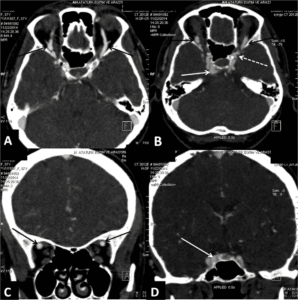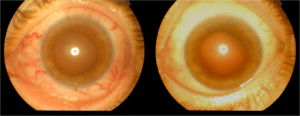Oktay Algin1*
1Ankara University, Medical Faculty, Department of Radiology, Ankara, Türkiye
2National MR Research Center (UMRAM), Bilkent University, Ankara, Türkiye
3Interventional MR Clinical Ra nd D Center, Ankara University, Ankara, Türkiye
*Correspondence author: Prof. Oktay Algin, MD, Interventional MR Clinical R and D Center, Ankara University, Ankara, Türkiye; Email: [email protected]
Published Date: 31-12-2023
Copyright© 2023 by Algin O. All rights reserved. This is an open access article distributed under the terms of the Creative Commons Attribution License, which permits unrestricted use, distribution, and reproduction in any medium, provided the original author and source are credited.
Abstract
A posterior fossa dural arteriovenous fistula presenting clinically as a carotid-cavernous fistula is a very rare and relatively unknown situation. They present with several clinical symptoms due to abnormal or excessive blood flowing into the cavernous sinuses. Although abnormal shunts between two vascular domains near each other may be expected (as in carotid-cavernous fistulas), an abnormal shunt from a distant artery to a cavernous venous sinus would be something unusual. Endovascular treatment is now the first-line, safest and cost-effective treatment for this type of fistula. In this paper, we report a very rare situation (a spontaneous posterior fossa dural arteriovenous fistula presenting clinically as a carotid-cavernous fistula) that is treated with endovenous intervention and coil embolization. The importance of other cavernous sinus-related fistulas, their diagnostic features and therapeutic options will also be discussed in this paper.
Keywords: Carotid Cavernous Fistula; Embolization; Imaging; Endovascular Treatment; Dural Arteriovenous Fistula; Inferior Petrosal Sinus
Introduction
Carotid-Cavernous Fistulas (CCFs) are well-known abnormal vascular shunts with direct or indirect abnormal blood flow from the cavernous carotid artery to venous sinuses [1]. It usually presents with ophthalmic symptoms. Anterior venous drainage in a dural Arteriovenous Fistula (dAVF) causes ocular symptoms, tinnitus, and/or pain similar to CCF. Endovascular treatment is the best treatment modality of choice in these cases [1]. In this paper, we report a case with a non-traumatic dAVF which was treated by an endovenous intervention. The importance of cavernous sinus-related fistulas, as well as their imaging features and therapeutic options, are also discussed in this manuscript.
Introduction
Carotid-Cavernous Fistulas (CCFs) are well-known abnormal vascular shunts with direct or indirect abnormal blood flow from the cavernous carotid artery to venous sinuses [1]. It usually presents with ophthalmic symptoms. Anterior venous drainage in a dural Arteriovenous Fistula (dAVF) causes ocular symptoms, tinnitus, and/or pain similar to CCF. Endovascular treatment is the best treatment modality of choice in these cases [1]. In this paper, we report a case with a non-traumatic dAVF which was treated by an endovenous intervention. The importance of cavernous sinus-related fistulas, as well as their imaging features and therapeutic options, are also discussed in this manuscript.
CTA revealed early contrast filling of cavernous venous sinuses and ophthalmic veins on both sides (being more prominent on the left side) (Fig. 1). A posterior fossa dAVF supplied by muscular/meningeal branches of the right vertebral artery was detected on Digital Subtraction Angiography (DSA) images. Most of the fistulous blood flow continued via paraclival veins, inter-cavernous connections towards the left cavernous sinus to the left superior ophthalmic vein, finally draining to facial veins (Fig. 2).
Endovascular treatment was scheduled for the next week under general anesthesia. For endovascular intervention, a 5 French (F) sheath system was inserted into the left common femoral artery and contrast injections through the right vertebral artery were used as a guideline. After puncturing the right common femoral vein and placing a 6F long sheath, a 6F guiding catheter was advanced to the left internal jugular vein over 0.035” glide-wire, through which a 5F vertebral-tip diagnostic catheter was used to catheterize the inferior and ostial part of the left inferior petrosal vein. Using this coaxial access system, a micro-catheter (SL-10, Stryker) was sent to the left cavernous sinus and then to the left superior ophthalmic vein over a 0.014” micro-guidewire. Embolization of the left superior ophthalmic vein, left paraclival vein and left cavernous sinus through this micro-catheter was achieved by electrolytically-detachable micro-coils starting from size 8×20 mm and seven coils sufficed for total closure of the vertebra-cavernous fistula, as proven by control runs. No peri-operative or post-operative complication was noted.
Follow-up ophthalmological examination a week after the endovascular treatment showed a symptom-free patient with near-complete resolution of the signs of eye congestion (Fig. 3). Three-tesla cranial MRI scan 2 weeks after the embolization did not show any evidence of adverse event but the disappearance of superior ophthalmic vein congestions on both sides (Fig. 4). At the follow-up visits 2 and 4 years later, the patient was completely returned to normal.
Discussion
Posterior fossa dAVF presenting with ocular congestive symptoms similar to CCF is very rare [2]. The fistula in our case was non-traumatic and spontaneously developed. The etiology of cavernous sinus-related fistulas includes aneurysms, genetic conditions, fibromuscular dysplasia, Ehlers-Danlos syndrome, pseudoxanthoma elasticum, arterial hypertension, atherosclerotic vascular disease, pregnancy, minor trauma, straining, diabetic vascular disease and collagen vascular diseases [1,3,4].
Treatment of CCF and dAVF aims to close the abnormal communication between the feeding artery/arteries and the cavernous sinus [2,5]. Therefore, the purpose of imaging is to specify the nature of the lesion, to detect arterial feeders and drainage veins, to assess its extensions various spatial plans and its effects on orbital structures and visual pathways [2,3]. Thin slices CT/MR images with time-of-flight MR angiography or CTA offer a precise depiction of these parameters [3,6]. Also, they can be extremely helpful in follow-up and they can eliminate unnecessary conventional angiographic exams [6].
Endovascular treatment of CCF and dAVF causes much less mortality and morbidity than open surgery [2,7]. The transvenous route, which is the safer method, should be preferred as the first-line option in endovascular treatment [8]. Trans-arterial therapy, microsurgery or percutaneous cannulations of superior-ophthalmic-vein/petrosal-sinuses may be preferred in cases where the trans-venous approach fails [2,4,8]. Also, in selected cases, transvenous embolization may be combined with these techniques [5].
The main goal of transvenous therapy is to block the fistulous point of dAVF, rather than the entire cavernous sinus [2,9]. For this purpose, transvenous access to the cavernous sinus through the inferior petrosal sinus is most frequently used [1]. If this approach fails, the target point can also be reached via the facial vein [8]. The use of detachable micro-coils is safer and more controlled than liquid embolizing agents, according to our own experiences. Also, micro-coils allow precise occlusion of the fistulous point and comparably good results have been achieved [5]. Microsurgery should not be banned from the treatment armamentarium and neurosurgeons must be able to achieve direct surgical occlusion when the angioarchitecture speaks against endovascular intervention [10]. We think that the success of simple coil embolization is due to a single drainage route of dAVF in our patient.
Conclusion
In conclusion, posterior fossa dAVF presenting clinically as a CCF is a very rare entity. A detailed radiological investigation is necessary for all cavernous sinus-related fistulas (including CCF or dAVF) for accurate therapy planning and endovascular intervention. Thin slices CT/MR images with TOF-MRA or CTA are the preferred imaging protocol for the evolution and follow-up of these lesions. Trans-venous embolization using micro-coils is a safe, effective and fast method. It should be the first-line choice in all cavernous sinus-related fistulas.
Conflict of Interest
The authors have no conflict of interest to declare.
References
- Ellis JA, Goldstein H, Connolly ES Jr, Meyers PM. Carotid-cavernous fistulas. Neurosurg Focus. 2012;32(5):E9.
- Tan AP, Taneja M, Hui F. Posterior fossa dural arteriovenous fistula presenting clinically as a carotid-cavernous fistula treated by a direct access cavernous sinus approach. BMJ Case Rep. 2013..
- Charbonneau F1, Williams M, Lafitte F, Héran F. No more fear of the cavernous sinuses! Diagn Interv Imaging. 2013;94(10):1003-16.
- Geibprasert S, Jiarakongmun P, Krings T, Pongpech S. Trigeminal fistula treated by combined transvenous and trans arterial embolization. Acta Neurochir (Wien). 2008;150(6):583-8.
- Chan YL, Shing KK, Wong KC, Poon WS. Transvenous embolization of a carotid-trigeminal cavernous fistula. Hong Kong Med J. 2006;12(4):310-2.
- Bakan AA, Alkan A, Kurtcan S, Aralaşmak A, Tokdemir S, Mehdi E, et al. Cavernous Sinus: A Comprehensive Review of its Anatomy, Pathologic Conditions and Imaging Features. Clin Neuroradiol. 2015;25(2):109-25.
- Morón FE, Klucznik RP, Mawad ME, Strother CM. Endovascular treatment of high-flow carotid-cavernous fistulas by stent-assisted coil placement. AJNR Am J Neuroradiol. 2005;26(6):1399-404.
- Suzuki S, Lee DW, Jahan R, Duckwiler GR, Viñuela F. Transvenous treatment of spontaneous dural carotid-cavernous fistulas using a combination of detachable coils and Onyx. AJNR Am J Neuroradiol. 2006;27(6):1346-9.
- Bernstein K, Teitelbaum GP, Herman B, Giannotta SL. Coil embolization of a trigeminal-cavernous fistula. AJNR Am J Neuroradiol. 1998;19(10):1953-4.
- Tinois J, Danassegarane G, Bretonnier M, Ferré JC, Morandi X, Corniola MV. Multidisciplinary management of posterior fossa dural arteriovenous fistula: A single-center experience. Neurochirurgie 2023;69(1):101389.
Article Type
Case Report
Publication History
Received Date: 11-12-2023
Accepted Date: 25-12-2023
Published Date: 31-12-2023
Copyright© 2023 by Algin O. All rights reserved. This is an open access article distributed under the terms of the Creative Commons Attribution License, which permits unrestricted use, distribution, and reproduction in any medium, provided the original author and source are credited.
Citation: Algin O. Diagnosis and Minimally-Invasive Treatment of Posterior Fossa Dural Arteriovenous Fistula Presenting Clinically as A Carotid-Cavernous Fistula. J Neuro Onco Res. 2023;3(3):1-5.

Figure 1: Preoperative CT angiography images of the patient (A-D). Bilateral dilation of superior ophthalmic veins (black arrows in A-C), early right cavernous sinus filling (with arrows in B, D) and fistulous point (dotted arrow in B) is observed on the images.

Figure 2: DSA images of the patient. Arterial feeders originating from muscular branches of the right vertebral artery (arrows in A), the fistulous points (arrows in B, C, E) and drainage veins (arrows in D) are visible. Subtracted (F, G) and roadmap (H) images demonstrating the course of the micro-catheter through the cavernous sinuses and left superior ophthalmic vein. The fistulous point (arrows in F, G) and the first coil detachment (arrow in H) are also seen. The final positions of detached coils are observed on non-subtracted images (arrows in I and J). After the embolization, subtracted vertebral angiograms confirmed complete closure of the fistula (K, L).

Figure 3: Preoperative chemosis (left) of the left eye is significantly regressed (right) in postoperative seven days. The right eye was also symptomatic, though less severe (not shown).

Figure 4: On the 14th postoperative day, 3-tesla MR images of the patient. Detached coils in the left superior ophthalmic vein and cavernous sinus were observed on T1W (A), T2W (B) and FLAIR (C-F) images (arrows). Superior ophthalmic vein congestion is no longer evident.


